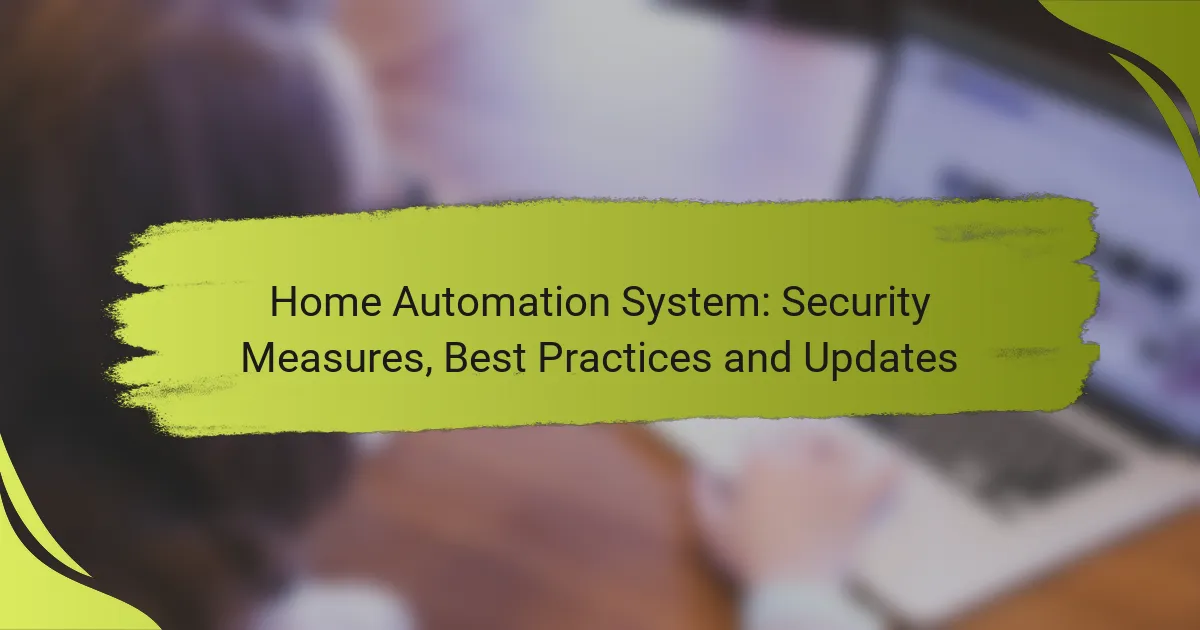Home automation systems offer innovative security measures that enhance safety and provide homeowners with greater control over their property. By integrating smart locks, security cameras, and motion sensors, these systems not only protect your home but also adapt to your lifestyle. To maximize effectiveness, it’s essential to evaluate your specific needs and follow best practices to safeguard against unauthorized access and vulnerabilities.
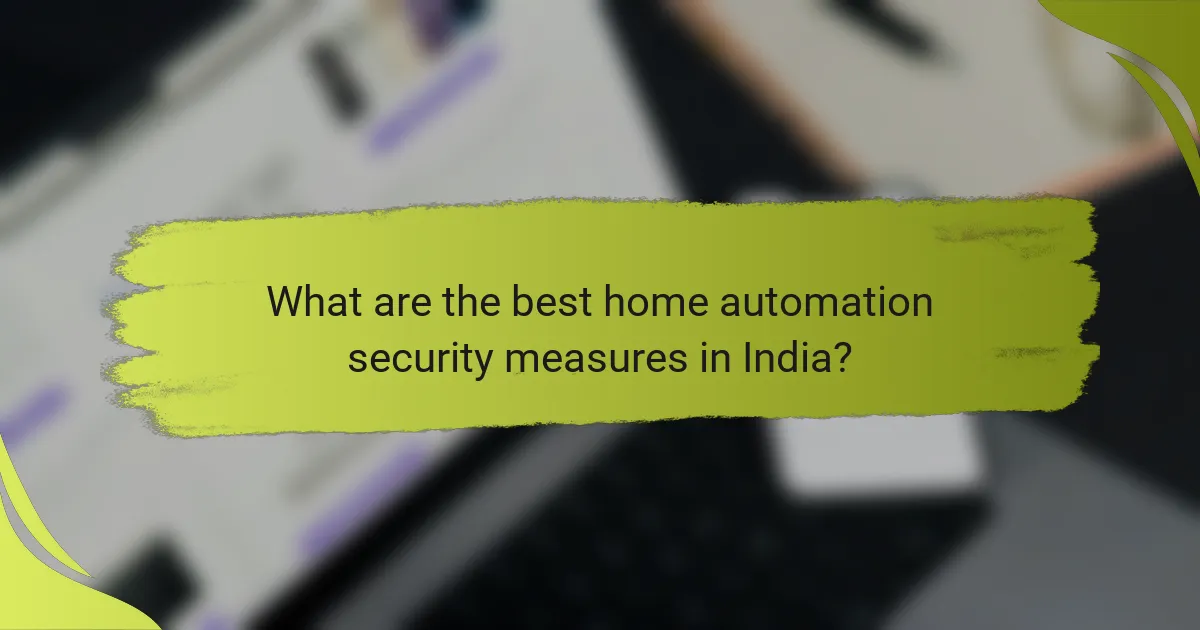
What are the best home automation security measures in India?
The best home automation security measures in India include smart locks, security cameras, alarm systems, motion sensors, and smart lighting. These technologies enhance safety and provide homeowners with greater control over their property.
Smart locks
Smart locks offer keyless entry and can be controlled remotely through a smartphone app. They often feature biometric access, such as fingerprint recognition, and can send alerts when someone enters or leaves the home.
When choosing a smart lock, consider compatibility with your existing door hardware and the security features offered, such as encryption and two-factor authentication. Popular brands in India include Godrej and Yale.
Security cameras
Security cameras are essential for monitoring your property in real-time. They can be accessed via mobile devices and often come with features like night vision, motion detection, and cloud storage for recorded footage.
Look for cameras that offer high-definition video quality and weatherproof designs for outdoor use. Brands like Hikvision and TP-Link provide reliable options for Indian homeowners.
Alarm systems
Alarm systems serve as a deterrent against intruders and can alert homeowners and authorities in case of a breach. Modern systems can integrate with other smart home devices for enhanced functionality.
Consider systems that offer both local and remote monitoring, and check for features like smartphone notifications and customizable settings. Brands like Honeywell and Zicom are popular in the Indian market.
Motion sensors
Motion sensors detect movement and can trigger alarms or notifications when unexpected activity occurs. They are often used in conjunction with security cameras and alarm systems for comprehensive coverage.
Choose sensors that can differentiate between pets and humans to reduce false alarms. Look for options with adjustable sensitivity settings to suit your home environment.
Smart lighting
Smart lighting can enhance security by allowing homeowners to control lights remotely, simulating occupancy when away. Timers and motion-activated lights can deter intruders by illuminating dark areas.
Consider using smart bulbs that can be programmed to turn on and off at specific times or in response to motion. Brands like Philips Hue and Syska offer a variety of smart lighting solutions suitable for Indian homes.
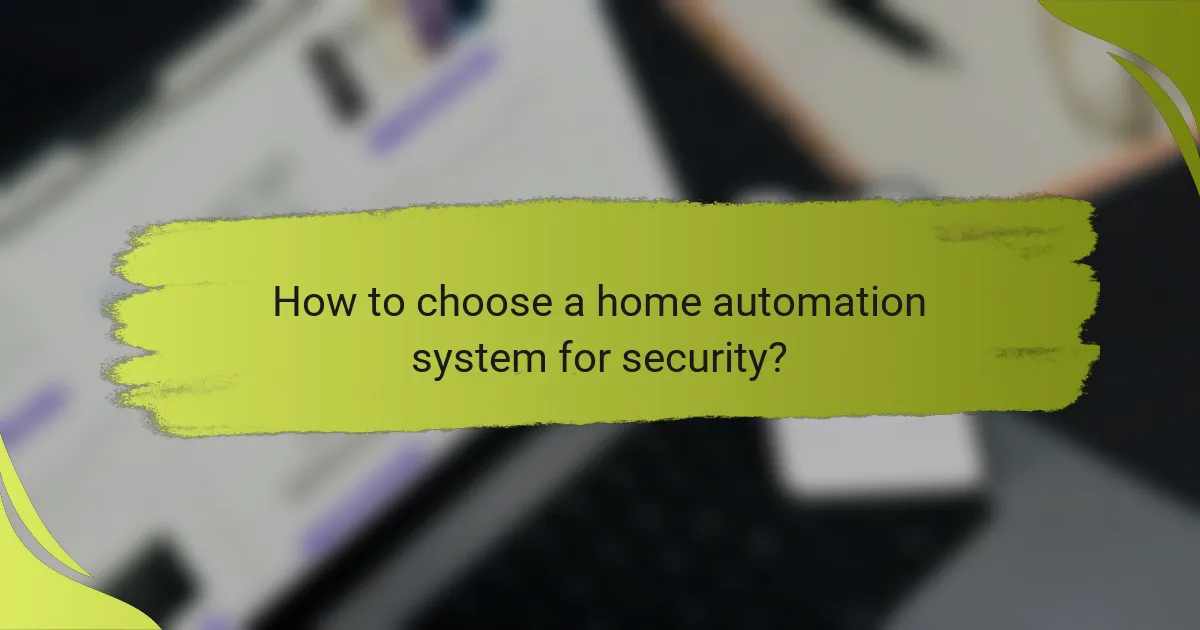
How to choose a home automation system for security?
Choosing a home automation system for security involves evaluating your specific needs, ensuring compatibility with existing devices, considering your budget, and planning for future scalability. A well-selected system enhances your home’s security while integrating seamlessly with your lifestyle.
Assessing security needs
Begin by identifying your security requirements, which may include monitoring, alarms, or remote access. Consider factors such as the size of your home, the number of entry points, and any specific vulnerabilities. For example, homes in urban areas may require more surveillance cameras compared to rural settings.
Evaluate potential threats, such as burglary or fire, and prioritize features like motion detection or smoke alarms. A comprehensive assessment helps in selecting a system that effectively addresses your unique security challenges.
Compatibility with existing devices
Check if the home automation system can integrate with your current devices, such as smart locks, cameras, or lighting systems. Compatibility ensures a cohesive security setup and reduces the need for additional purchases. Look for systems that support common protocols like Z-Wave or Zigbee.
Research the manufacturer’s specifications and user reviews to confirm compatibility. Systems that can easily connect with existing smart home devices offer greater flexibility and convenience.
Budget considerations
Your budget plays a crucial role in selecting a home automation system for security. Basic systems may start at a few hundred USD, while more advanced setups can exceed a thousand. Factor in both initial costs and ongoing expenses, such as subscription fees for cloud storage or monitoring services.
Consider potential savings from insurance discounts for enhanced security. Many providers offer packages that can fit various budgets, so explore options that provide the best value for your needs without compromising security.
Scalability options
Choose a home automation system that allows for future expansion. Scalability ensures that as your security needs evolve, your system can adapt without requiring a complete overhaul. Look for systems that offer modular components or additional features that can be added over time.
For instance, if you start with basic monitoring, you might later want to add smart locks or environmental sensors. A scalable system provides flexibility and longevity, making it a wise investment for your home’s security.
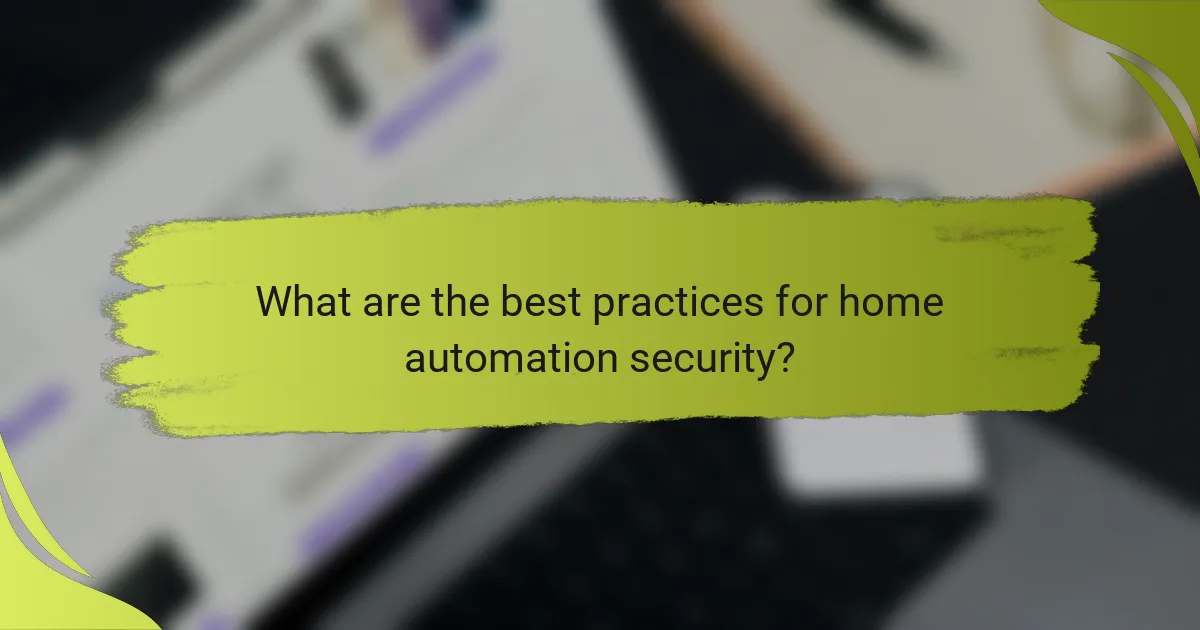
What are the best practices for home automation security?
Best practices for home automation security focus on protecting devices and networks from unauthorized access and vulnerabilities. Implementing these measures can significantly reduce the risk of security breaches and ensure a safer home environment.
Regular software updates
Regular software updates are crucial for maintaining the security of your home automation system. Manufacturers frequently release updates to patch vulnerabilities and improve functionality, so it’s essential to enable automatic updates or check for them manually on a consistent basis.
Set a schedule to review your devices for updates at least once a month. This practice helps ensure that all components, including hubs, cameras, and sensors, are running the latest software versions, minimizing the risk of exploitation by cybercriminals.
Strong password management
Strong password management is vital for safeguarding your home automation system. Use complex passwords that combine letters, numbers, and special characters, and avoid using easily guessable information like birthdays or common words.
Consider using a password manager to store and generate unique passwords for each device and account. Regularly update your passwords, especially if you suspect any device may have been compromised, and enable password protection on all devices.
Network security measures
Implementing robust network security measures is essential for protecting your home automation system. Start by securing your Wi-Fi network with WPA3 encryption and changing the default SSID and password to something unique.
Consider setting up a separate guest network for your smart devices, which can help isolate them from your main network. Regularly monitor connected devices and disable any that are no longer in use to reduce potential entry points for attackers.
Two-factor authentication
Two-factor authentication (2FA) adds an extra layer of security to your home automation system by requiring a second form of verification beyond just a password. This could be a text message code, an email confirmation, or an authentication app.
Enable 2FA on all compatible devices and accounts to significantly enhance security. This measure ensures that even if a password is compromised, unauthorized access is still prevented, making it a critical step in securing your home automation setup.
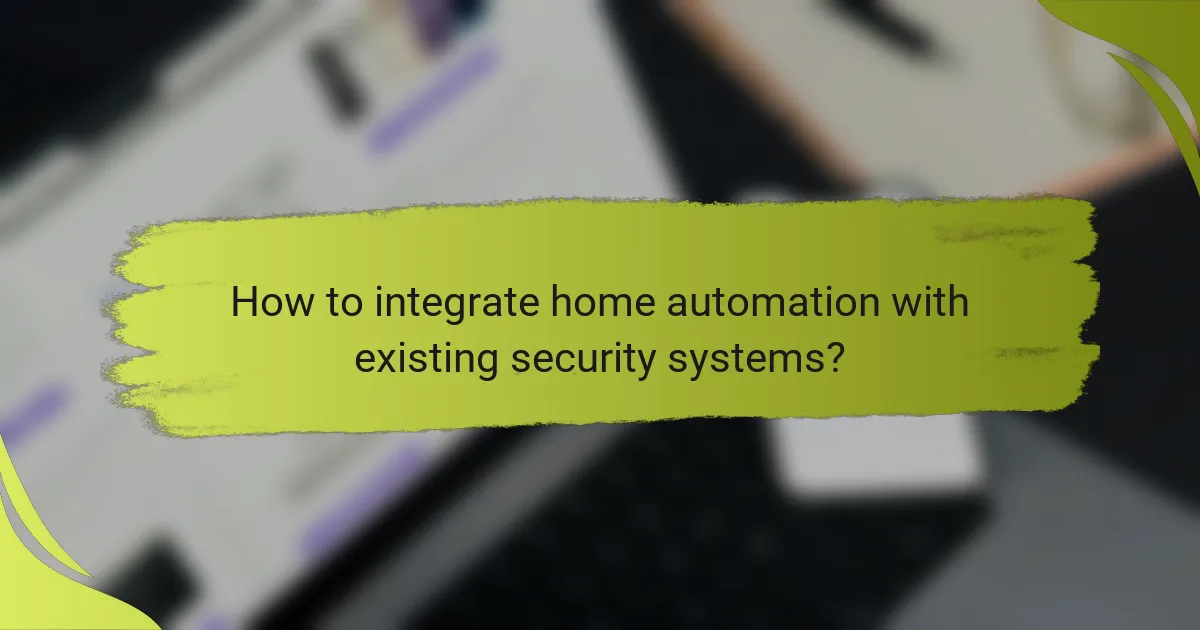
How to integrate home automation with existing security systems?
Integrating home automation with existing security systems enhances overall safety and convenience. This process typically involves connecting smart devices to your current security framework, allowing for seamless control and monitoring.
Using smart hubs
Smart hubs serve as central control points for various home automation devices, including security systems. They allow different devices to communicate with each other, regardless of brand or protocol, simplifying management through a single interface.
When selecting a smart hub, consider compatibility with your existing security devices. Popular options include Samsung SmartThings, Amazon Echo Plus, and Google Nest Hub, which can support a range of protocols like Zigbee and Z-Wave.
Connecting devices via apps
Many modern security systems come with dedicated mobile apps that facilitate integration with home automation features. These apps enable users to control security cameras, alarms, and locks remotely, providing real-time alerts and monitoring.
Ensure that the apps you choose are user-friendly and compatible with your devices. Look for features such as push notifications, video streaming, and the ability to create automation routines that link security actions with other smart home functions.
Professional installation services
For those who prefer a hassle-free setup, professional installation services can ensure that your home automation and security systems are integrated correctly. Experts can assess your home’s layout and recommend the best configuration for optimal performance.
When hiring a professional, check for certifications and customer reviews to ensure quality service. This investment can save time and prevent potential issues that may arise from DIY installations, particularly with complex systems.
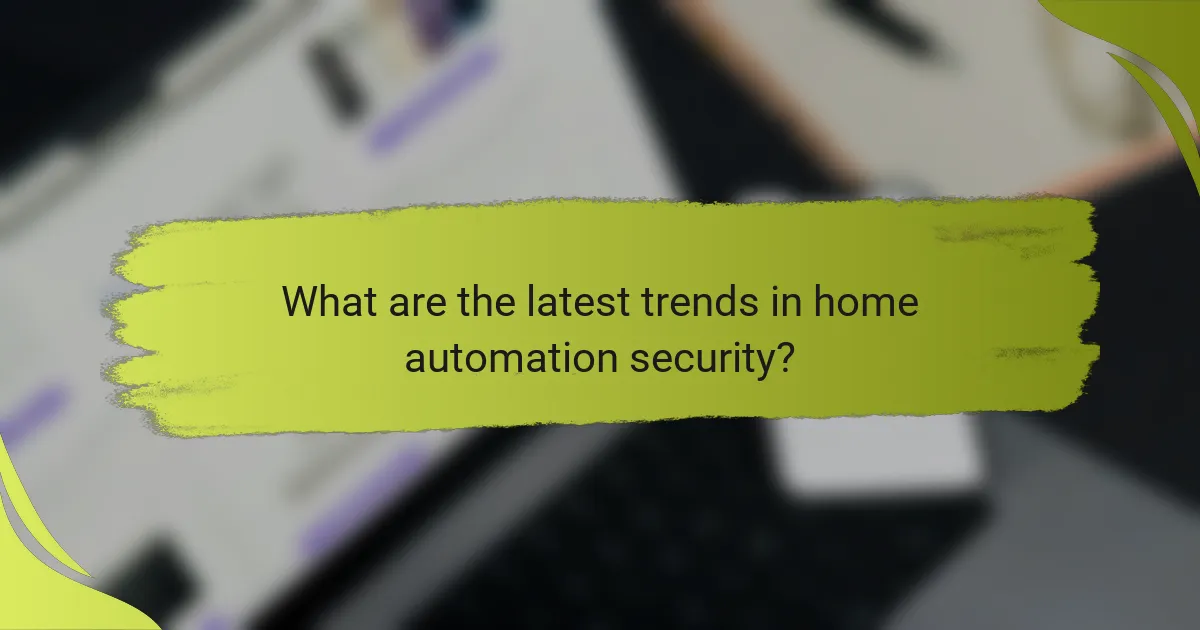
What are the latest trends in home automation security?
The latest trends in home automation security focus on enhancing safety through advanced technologies and seamless integration. Key developments include AI-driven solutions, improved remote monitoring capabilities, and better integration with existing smart home systems.
AI-driven security solutions
AI-driven security solutions utilize machine learning algorithms to analyze data from various sources, improving threat detection and response times. These systems can differentiate between normal and suspicious activities, reducing false alarms and enhancing overall security effectiveness.
For example, AI can analyze video feeds to identify unusual movements or recognize familiar faces, alerting homeowners only when necessary. Investing in such technology can significantly bolster home security while minimizing unnecessary disruptions.
Remote monitoring advancements
Recent advancements in remote monitoring allow homeowners to oversee their property from anywhere using mobile apps and cloud-based services. These systems often feature real-time alerts, live video feeds, and two-way communication, providing peace of mind while away from home.
Many remote monitoring solutions now support integration with smart devices, enabling users to control locks, lights, and cameras remotely. When selecting a system, consider options that offer high-definition video and low-latency streaming for optimal performance.
Integration with smart home ecosystems
Integration with smart home ecosystems is becoming increasingly important for enhancing home security. Systems that work seamlessly with existing smart devices, such as smart locks, lights, and alarms, provide a more comprehensive security solution.
When choosing security products, look for compatibility with popular smart home platforms like Google Home or Amazon Alexa. This integration allows for automated routines, such as locking doors and turning on lights when you leave home, creating a more secure environment effortlessly.
